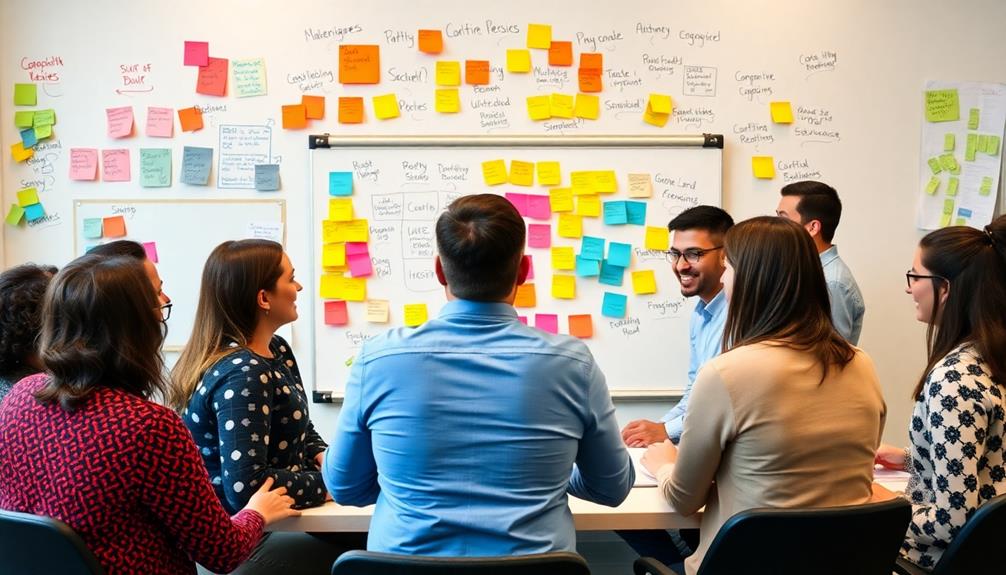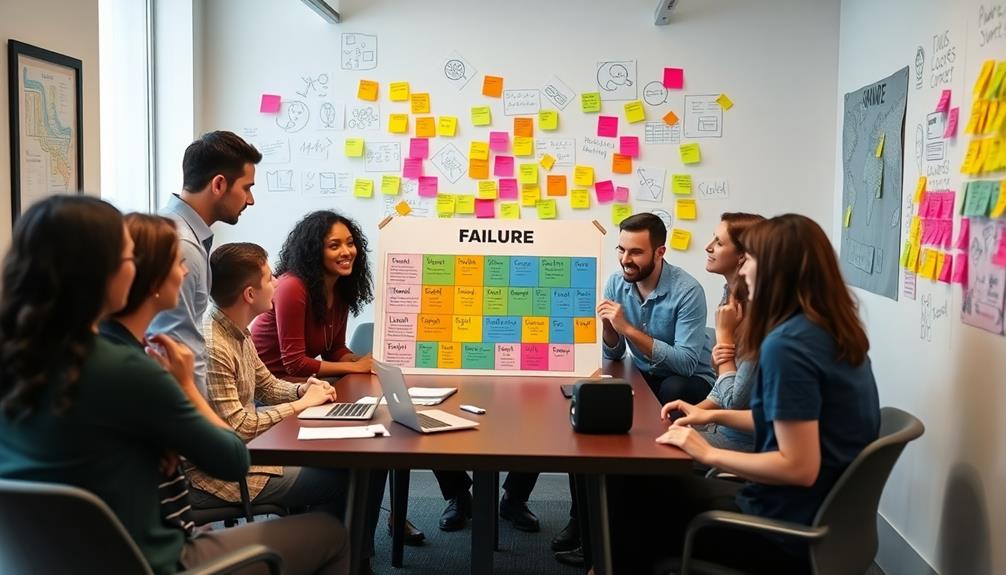To foster a culture of curiosity in your organization, start by prioritizing open dialogue and active listening. Encourage managers to adopt coaching techniques that focus on development and exploration. Empower teams to make decisions, promoting diverse perspectives and collaborative problem-solving. Create a safe environment for sharing ideas and accepting failures as learning opportunities. Recognize and reward innovative thinking to boost motivation. Incorporating new technologies can inspire creativity, while courageous conversations enhance collaboration. By nurturing these elements, you can cultivate a dynamic workplace that thrives on curiosity and innovation. Explore additional strategies to elevate this culture even further.
Key Takeaways
- Encourage open dialogue and psychological safety, allowing employees to share ideas without fear of judgment or failure.
- Implement regular brainstorming sessions and team-building activities to stimulate collaboration and idea-sharing across departments.
- Recognize and reward innovative thinking to motivate employees and foster a dynamic workplace culture.
- Promote learning from failures by embracing a "fail fast" approach and conducting structured reflection sessions to derive valuable insights.
- Showcase new technologies and facilitate workshops to empower teams to explore and experiment with innovative tools and practices.
Train Managers in Coaching Techniques

In many organizations, fostering a culture of curiosity starts with how managers interact with their teams. By training managers in effective coaching techniques, you can create an environment that encourages curiosity and innovation.
Coaching leadership emphasizes development over mere performance correction, allowing team members to explore ideas freely without the fear of failure. When you empower your managers to prioritize listening over talking, they'll enhance psychological safety, making it easier for employees to express their thoughts and ideas.
Additionally, integrating practices such as self-care and mindfulness into the workplace can further enhance emotional health, enabling employees to engage more openly.
Research shows that organizations with a coaching-focused leadership style report higher employee satisfaction and lower turnover rates. When team members feel supported in their growth, they're more likely to engage in open dialogue and collaboration.
By bridging silos between groups, coaching techniques foster teamwork and collective creativity, which are crucial for driving innovation.
Encouraging curiosity isn't just about asking questions; it's about creating a culture where exploration is welcomed. As your managers adopt these coaching techniques, you'll notice a shift in your organization's atmosphere—one that inspires creativity and a willingness to learn.
This foundational change can lead to more engaged employees and a thriving, innovative workplace.
Empower Teams in Decision Making

When you empower your teams to make decisions, you ignite a powerful collective problem-solving approach.
By encouraging diverse perspectives and fostering a culture of abundance, you not only boost creativity but also create a sense of ownership that enhances engagement.
This collaborative environment can lead to innovative solutions and a more satisfied workforce.
Collective Problem-Solving Approach
Empowering teams in decision-making not only boosts engagement but also sparks innovation. When you embrace a collective problem-solving approach, you create an environment where employee involvement flourishes. This method encourages team members to share their insights and take ownership of the outcomes, enhancing accountability and motivation.
Implementing collective problem-solving can lead to significant improvements in your organization. Here's a quick look at its benefits:
| Benefit | Impact on Organization | Effect on Employees |
|---|---|---|
| Increased Productivity | 20% rise in productivity | Greater job satisfaction |
| Enhanced Problem-Solving | 30% more effective teams | Feeling valued and included |
| Reduced Resistance to Change | Smoother adjustments | Higher engagement levels |
Encourage Diverse Perspectives
Diverse perspectives are essential for effective decision-making, as they bring a wealth of ideas and solutions to the table. When you empower your teams to contribute their unique viewpoints, you not only boost engagement but also enhance creativity and innovation.
Research shows that teams embracing varied perspectives are 60% more effective at problem-solving. By fostering an environment where team members feel comfortable sharing their thoughts, you create a sense of ownership that can increase job satisfaction by 20% and improve retention rates.
Furthermore, incorporating techniques from personal development can further enhance team dynamics and individual contributions.
Encouraging open dialogue across departments helps break down silos, doubling the likelihood of generating innovative ideas through collective input. When employees feel valued for their contributions, they're 4.6 times more likely to perform at their best.
In addition, organizations that leverage diverse teams for decision-making are 1.7 times more likely to be innovation leaders in their industries.
To cultivate this culture, actively invite input from all team members and guarantee everyone has a voice. By doing so, you'll empower your teams to make informed decisions while fostering a thriving, curious organization.
Create a Safe Idea Environment

To foster a safe idea environment, you need to encourage open sharing among your team members.
Accepting failure as a learning opportunity helps build trust and empathy, creating a culture where everyone feels valued.
When people know they can express their thoughts without fear, innovation thrives.
Encourage Open Sharing
Creating a safe environment for idea sharing is essential for fostering a culture of curiosity within your organization. When you encourage open sharing, employees feel more comfortable expressing their thoughts without fear of judgment. This openness fosters trust and lays the groundwork for effective communication among teams.
To enhance employee engagement, provide resources for idea development and execution. When employees see that their ideas are valued and nurtured, they're more excited to contribute innovative solutions, creating a dynamic workplace culture.
Promote open dialogue and encourage diverse perspectives; this approach can lead to the exploration of new ideas and greatly boost your organization's innovation capabilities.
Consider implementing anonymous submission channels for ideas. This can facilitate candid feedback and help individuals feel more at ease when sharing their thoughts. The more comfortable your employees feel, the more likely they're to share bold ideas that can drive your organization forward.
Accept Failure as Learning
Accepting failure as a part of the learning process is essential for fostering a safe idea environment within your organization. When you embrace failure, you encourage your team to take calculated risks, which can lead to innovative solutions. This culture of experimentation ignites curiosity among employees, making them feel empowered to share their ideas without fear of judgment.
By creating a space where failure is viewed as an opportunity for growth, you'll notice a significant increase in employee engagement—up to 37%. Team members will feel valued and supported, leading to a more dynamic exchange of ideas.
Additionally, accepting failure helps reduce the fear associated with proposing new initiatives, ultimately boosting your creative output by 50%.
Establishing clear mechanisms for feedback on failed projects is vital. This allows your organization to extract valuable lessons that enhance decision-making and innovation efforts.
Companies that actively promote learning from failure report a 25% improvement in overall team performance. As employees become more resilient and adaptable, they're more likely to contribute to an environment rich in curiosity and continuous improvement.
Embrace failure, and watch your organization thrive.
Foster Trust and Empathy
Building on the foundation of learning from failure, fostering trust and empathy within your organization is essential for creating a safe environment where ideas can flourish.
Establish clear norms that promote open dialogue, ensuring team members feel comfortable sharing without fear of judgment. This psychological safety can boost performance by 12%, highlighting the significance of trust and empathy in your culture.
Empathetic leadership practices—like active listening and validating contributions—can drastically reduce stress and burnout by up to 40%. When employees feel heard and valued, they're more likely to engage in creative problem-solving and share innovative ideas.
Regular check-ins and feedback sessions help cultivate this trust, allowing diverse perspectives to surface and thrive.
Encouraging acceptance of failure as a learning opportunity empowers about 70% of workers to express their ideas in a supportive atmosphere.
By prioritizing trust and empathy, you not only enhance employee morale but also lay the groundwork for sustained curiosity and innovation.
Embrace these practices, and watch your organization transform into a vibrant hub of creativity and collaboration.
Prioritize Active Listening

Active listening is a powerful tool that can transform your organization's communication dynamics. By prioritizing active listening, you create a culture that embraces open dialogue, where team members feel psychologically safe to share their ideas and thoughts.
When employees know their voices matter, engagement can soar by up to 50%, driving innovation and collaboration.
Active listening goes beyond just hearing words; it involves understanding the emotions and intentions behind them. This practice not only strengthens relationships but also builds trust among team members.
Techniques like reflective listening and paraphrasing validate contributions, reinforcing an environment where curiosity thrives.
When you implement active listening strategies, you can expect a 20% improvement in overall employee satisfaction. As people feel more connected and supported in their roles, they'll be more willing to explore new ideas and challenge the status quo.
Ultimately, fostering a culture that embraces active listening allows for greater creativity and problem-solving.
Foster Cross-Department Collaboration

Creating a culture of active listening naturally paves the way for greater cross-department collaboration. When you encourage employees to share their ideas and insights, you break down silos that often hinder innovation.
By fostering a culture of openness, you enable diverse perspectives to come together, which enhances problem-solving capabilities.
Consider organizing team-building activities that emphasize trust and communication. These initiatives can lead to stronger relationships among departments, resulting in increased collaboration on innovative projects.
Research indicates that companies promoting interdepartmental collaboration see a 30% boost in productivity, as employees share knowledge and resources more effectively.
Encouraging cross-functional teams to tackle specific challenges allows you to leverage the unique strengths of different departments. This collaboration often leads to more holistic and creative solutions.
Additionally, regular interdepartmental meetings or brainstorming sessions can stimulate curiosity and idea-sharing, making collaborative problem-solving the norm in your organization.
Reward Innovative Thinking

To truly spark innovative thinking in your organization, you need to incentivize creative ideas and recognize those who take risks.
When employees see that their efforts are appreciated, even if they don't always succeed, they're more likely to push boundaries.
This approach not only boosts morale but also cultivates a culture where creativity thrives.
Incentivize Creative Ideas
A robust incentive program can transform the way your organization approaches innovation. By implementing Key Performance Indicators (KPIs) that reward innovative strategies, you can greatly boost employee motivation and creativity.
Research shows that organizations with incentive programs for innovation report a 35% increase in employee engagement and a 20% rise in overall productivity. When you provide bonuses or recognition for successful ideas, you not only encourage participation but also foster a sense of ownership and accountability among your team.
Creating an environment that incentivizes creative ideas encourages calculated risk-taking and learning from failures. Employees will feel safe to experiment with new concepts without fearing negative repercussions.
This positive organizational culture promotes adaptability and responsiveness in a competitive market. Regularly reviewing and adapting existing practices, while offering incentives for those contributing creative solutions, keeps your team engaged and invested in the organization's success.
Ultimately, a well-structured incentive program can be a game changer. It cultivates a dynamic workplace where innovative thinking thrives, empowering your employees to push boundaries and drive the organization forward.
Recognize Risk-Taking Efforts
Encouraging an environment where risk-taking is recognized can significantly amplify your organization's innovative capabilities. When you recognize risk-taking efforts, you're not just rewarding creativity; you're fostering a culture where curiosity thrives. This recognition can lead to increased employee engagement, motivation, and retention.
Implementing structured acknowledgment systems, like innovation awards, helps reinforce the importance of curiosity and experimentation in your team. Here's a table to illustrate the benefits of recognizing risk-taking efforts:
| Benefit | Impact (%) | Description |
|---|---|---|
| Employee Engagement | 30% | Employees feel valued and motivated. |
| Successful Project Implementations | 20% | More projects succeed when creativity is rewarded. |
| New Ideas Generated | 25% | Incentives lead to a surge in creative solutions. |
| Retention Rates | 15% | Recognition fosters commitment and loyalty. |
Embrace Learning From Failures

Embracing failures as learning opportunities can transform the dynamics of your organization. By adopting a "fail fast" approach, you encourage experimentation, allowing your teams to quickly learn from setbacks. This willingness to innovate and iterate can lead to significant breakthroughs and improved outcomes.
When your organization fosters a culture of learning from failures, you'll notice higher levels of employee engagement. Individuals feel empowered to take calculated risks without the fear of punitive consequences.
A study by the Harvard Business Review underscores that companies embracing failure as part of their innovation process often gain competitive advantages. Promoting acceptance of failure boosts psychological safety, which enhances collaboration and creative problem-solving among teams.
To maximize these benefits, consider implementing structured reflection sessions after projects. These sessions help your teams analyze failures constructively, turning setbacks into valuable learning experiences that inform future strategies.
Showcase New Technologies

Showcasing new technologies can dramatically enhance your organization's innovative spirit. By demonstrating practical applications of cutting-edge tools like AI and automation, you inspire your teams to embrace these innovations.
When you showcase new ideas through workshops or demo sessions, employees feel empowered to explore and experiment, leading to heightened engagement and creativity.
Integrating these technologies into daily operations allows your teams to leverage them for problem-solving, generating fresh perspectives that can transform work processes. Regular exposure to new technologies not only fosters curiosity but also equips your employees with the skills needed to generate creative solutions.
Highlighting successful case studies or testimonials from within your organization further motivates teams to adopt similar approaches. When they see their peers effectively using these tools, they're more likely to embrace a culture of continuous learning and experimentation.
Ultimately, by embedding innovative practices into your workflow, you elevate your organization's overall capabilities. Encourage your teams to stay curious and explore the latest advancements, and watch as their enthusiasm and productivity soar.
Embracing new technologies paves the way for a more dynamic and innovative workplace.
Offer Diverse Contribution Methods

By offering diverse contribution methods, you can create an inclusive environment where every employee feels empowered to share their ideas.
Encouraging a variety of channels for idea generation fosters a company culture rich in new ideas and innovation. Here are three effective methods to contemplate:
- Anonymous Submissions: Allow employees to submit ideas anonymously. This encourages candid feedback and promotes contributions from those who might hesitate to speak up in a larger group.
- Open Innovation Meetings: Schedule dedicated team meetings focused on brainstorming and innovation. These sessions invite all members to share their insights, fostering a collaborative atmosphere that values diverse perspectives.
- Competitions for Innovative Ideas: Organize competitions that reward the best ideas. This not only sparks creativity but also motivates employees by acknowledging their contributions to innovation.
Cultivate Courageous Conversations

Encouraging diverse contribution methods sets the stage for a culture where courageous conversations can thrive. When you create environments that invite employees to share controversial or opposing views, you open the door to innovative solutions and collective problem-solving.
By fostering discussions that promote active listening and curiosity, you help your team feel safe expressing their thoughts, which ultimately strengthens collaboration and team dynamics.
Setting clear intentions for constructive dialogue is essential. It embraces diverse opinions and encourages open-mindedness among team members, making everyone feel valued and recognized for their contributions.
Research shows that organizations prioritizing courageous conversations experience increased engagement, as employees are more inclined to participate in a psychologically safe environment.
To truly cultivate these conversations, develop structured frameworks that guide teams in addressing conflicts effectively. This approach not only promotes psychological safety but also builds trust among colleagues.
By encouraging courageous conversations, you're not just facilitating communication; you're nurturing a culture where curiosity can flourish, leading to richer insights and more robust outcomes.
Embrace this practice, and watch your organization thrive.
Frequently Asked Questions
How to Foster a Culture of Curiosity?
To foster a culture of curiosity, you should create an open environment where everyone feels safe to share ideas without fear of judgment.
Encourage regular inquiry-based meetings focused on exploration rather than presentations.
Break down silos by promoting collaboration across departments.
Recognize and reward curiosity-driven behaviors, and integrate curiosity evaluations into performance reviews.
How to Foster Curiosity in the Workplace?
Curiosity's the compass guiding innovation, right? To spark it in the workplace, start by creating a safe space for open discussions.
Encourage your team to share wild ideas without worrying about judgment. Organize collaborative activities that mix different departments, fostering diverse viewpoints.
Set learning goals instead of performance metrics, and provide resources for self-directed exploration. This way, you'll cultivate an environment where curiosity thrives and creativity flows naturally.
How to Be Culturally Curious?
To be culturally curious, you've gotta actively seek out diverse perspectives.
Start by engaging with people from different backgrounds and asking open-ended questions. Explore new ideas and challenge your own assumptions.
Attend events or workshops focused on various cultures, and immerse yourself in their traditions.
Don't hesitate to share your own experiences, as this fosters dialogue.
How to Foster Culture in an Organization?
Creating a culture in an organization is like planting a garden; it requires nurturing and attention.
Start by defining a clear vision that aligns with your values, and involve everyone in shaping it. Encourage open communication, making sure team members feel safe to share their thoughts.
Recognize and reward contributions, and promote collaboration across departments. Regular feedback helps identify barriers, fostering an environment where innovation and growth can truly thrive.
Conclusion
By fostering a culture of curiosity, you're not just releasing potential—you're igniting a wildfire of innovation that can transform your organization. Encourage open dialogue, embrace learning opportunities, and celebrate every unique idea that comes your way. When you empower your teams and prioritize collaboration, you'll create an environment where creativity thrives. Remember, curiosity isn't just a trait; it's the secret sauce that can propel your organization to unimaginable heights. So, let curiosity lead the way!









